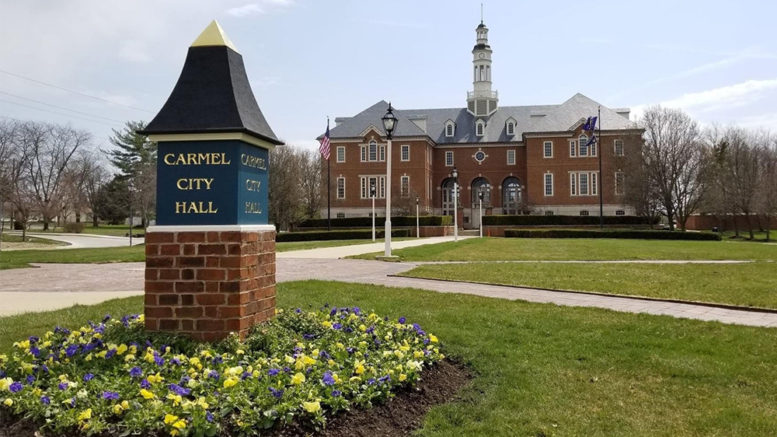By STU CLAMPITT
news@readthereporter.com
Carmel Mayor Sue Finkam is using a “zero-based budgeting model” for the city, a very different method of fund allocation than Carmel has seen in previous administrations. The Reporter was invited to talk to Mayor Finkam and CFO Zachary Jackson about this model and what it could mean for Carmel’s financial future.
Zero-based budgeting should not be confused with a balanced budget.

Finkam
“I read something about another city supposedly doing zero-based budgeting – not in your publication, by the way – and it said zero-based budgeting is when revenue minus expenses equals zero,” Finkam said. “That’s not accurate. That’s a balanced budget. We’re doing a zero-based budgeting approach to get to a balanced budget, or better than a balanced budget.”
Zero-based budgeting assumes that each department in the city gets no funding other than what it takes to cover existing employees. Every dollar above that has to be justified.
“The typical way we did our budgets here was if your department director and your budget had been a million dollars a year before, the budget guidance would come out – from usually the director of administration and the mayor – saying don’t increase your budgets more than 3 percent, 5 percent, or whatever the number was. What we said to them is ‘What do you need to do your job; to serve our constituents based on the priorities in the Elevate Caramel Plan? Go. Assume you get nothing other than your employees.’ We did not say you have to rebuild your employee base. But what expenses do you need to get the job done?”
Expenses other than current employees had to be grouped into “programs.” As an example, running snow removal in winter would be a snowplow program.
Jackson explained it to The Reporter with a grocery store analogy where programs are the bundled sets of expenses a department wants or needs to run.

Jackson
“I use the analogy of a shopping cart,” Jackson said. “Tell us what programs you want to put in there, and before we get to the checkout lane of city council, the mayor and I will work with each department head and decide what gets to stay in the shopping cart or what needs to be put back on the shelf because either we can’t afford it or just the cost of that program compared to the priority just didn’t make sense.”
By doing this year after year, the city will be able to look at the performance of each program compared to its cost to determine if it is worth the money, if the program needs to be cut, or if the program needs to be funded at a higher level to make it more effective for citizens.
While tracking expenses and their effectiveness is nothing new, assuming a zero-dollar baseline every fiscal year is very new in Carmel.
“Assume your base is nothing,” Finkam said. “Your base is nothing every year. So next year we’ll do it again. Again, the base is zero. Assume you don’t necessarily get those dollars.”
According to Finkam, in previous budget processes, departments would get an increase in funding as a direct reflection of the increase in the city’s overall budget. That also meant that the total allocation of public funds for each department would be that same percentage of the entire budget.
Public safety is getting a higher percentage of this budget because Carmel has faced challenges in recruiting and retaining police and fire personnel. With open positions in those departments, overtime costs have been up in recent years. Public safety personnel leave Carmel police and fire for multiple reasons. Some find it is not the right career for them. Some transfer to other departments. Some are drawn away to other cities by better offers. Finkam told The Reporter that last reason is what she hopes to address through budget priorities.
“I think our major issue there is the pay that we were offering wasn’t as attractive as it needed to be,” Finkam said. “By addressing the pay, my hope is that we can recruit and retain more than we have in the past, which will eventually help to drive overtime costs down.”
In addition to recruiting good people to work in these departments, retaining them throughout a career is important – and expensive.
“We redid the matrices that the police and fire are paid by [in order] to increase their pay as they get through later years of their career,” Finkam said. “Market compensation has gone up significantly for police in particular, but also for fire.”
This increased cost is being paid for, in part, by moving expenses from places they should not have been to places they should, and by refunding bonds at a lower rate without extending the life of the bond itself.
“This general administration department that we had before was a good example,” Jackson said. “It paid for the cost of maintaining City Hall, but it also had other costs that – they weren’t inappropriate expenses – they just made more sense to move elsewhere. For example, we offer our retirees a supplement on their health insurance if they were here for 20 years or more. We paid that out of our general administration line instead of out of our HR agencies. Same thing with some of our workers’ costs. Same thing with our property casualty insurance. So, in this budget, we tried to be more transparent. Instead of being a vague ‘general administration,’ we’ve tried to move things out and rename some of the funds – departments, too – just to be more clear.”
There are numerous other examples of programs paid for from funds that this newspaper finds obscure and confusing.
“We also – for some reason – have usually made our city’s debt service payments out of our Board of Public Works,” Jackson said. “And again, I can’t figure out why that was done. We’ve moved that to the Finance Department. We [the Finance Department] were making them before, but just on behalf of another department. The Board of Public Works is three people that review contracts and other things before they move forward.”
According to Jackson, moving debt service payments from the Board of Public Works to the Finance Department “just made a lot more sense.”
At the beginning of the Carmel City Council Budget Hearing on Sept. 25, which you can view in its entirety online, Mayor Finkam said, “What got us here today won’t get us there tomorrow.”
Finkam was elected in part on a platform of increased transparency. While this newspaper finds her administration more transparent than others have been, in a few years it will be up to voters to decide if they agree.
You can watch the full Sept. 25 Carmel City Council Budget Hearing online at tinyurl.com/56ju9hwn. The second day of those hearings is online at tinyurl.com/4ufm6r94.
The 2025 proposed City budget totals $234.8 million, with a General Fund budget of $146 million.
You can read the 2025 proposed budget at tinyurl.com/Carmel2025BudgetProposed.
Budget details are available at tinyurl.com/Carmel2025BudgetDetailed.
The proposed budget will be introduced to the council on Oct. 7. It will be eligible for adoption on Oct. 21.

